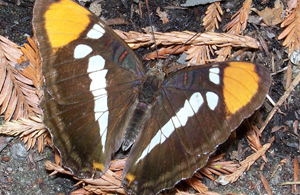|
Do you see/hear...?
|
| Activity
|
Adults
One or more adults are seen or heard moving about or at rest.
More...
For abundance, enter the number of individual animals observed in this phenophase.
|
|
|
Adults feeding
One or more adults are seen feeding with their straw-like tongue (proboscis). If possible, record the substance and species on which they are feeding (for example, nectar, sap, dung, or moist soil) in the comments field. For Adelpha californica, adults feed on tree sap, rotting fruit, flower nectar and animal droppings.
For abundance, enter the number of individual animals observed in this phenophase.
|
|
|
Flower visitation
One or more individuals are seen visiting flowers or flying from flower to flower. If possible, record the name of the plant or describe it in the comments field.
For abundance, enter the number of individual animals observed in this phenophase.
|
| Reproduction
|
Mating
A male and female are seen coupled in a mating position, usually end to end. This can occur at rest or in flight.
For abundance, enter the number of individual animals observed in this phenophase.
|
|
|
Egg laying
A female is seen laying eggs on a plant or other surface. If possible, record the name of the plant or describe it in the comments field. For Adelpha californica, eggs are typically deposited on the leaves of oak trees.
For abundance, enter the number of individual animals observed in this phenophase.
|
|
|
Eggs
One or more eggs are seen on a plant or other surface. If possible, record the name of the plant or describe it in the comments field. For Adelpha californica, the tiny, spherical, green eggs are covered in a polygonal, net-like pattern with raised white bristles, and are typically found on the tips of leaves of oak trees.
For abundance, enter the number of individual animals observed in this phenophase.
|
| Development
|
Caterpillars
One or more caterpillars (larvae) are seen moving about or at rest. When seen on a plant, if possible, record the name of the plant or describe it in the comments field. For Adelpha californica, young caterpillars are brownish-green with a brown head. Older caterpillars are reddish-brown, eventually turning green, with reddish-brown, spiny "horns" on their back. When resting or disturbed they take on a hunched, S-shaped posture.
For abundance, enter the number of individual animals observed in this phenophase.
|
|
|
Caterpillars feeding
One or more caterpillars are seen feeding. If possible, record the name of the species or substance being eaten or describe it in the comments field. For Adelpha californica, caterpillars typically feed on the leaves of oak trees.
For abundance, enter the number of individual animals observed in this phenophase.
|
|
|
Pupae
One or more pupae are seen in a cocoon or shell (puparium). For Adelpha californica, pupae are pale brown to pale yellow with streaks of dark brown and iridescent coloring, and hang from plants or other outdoor surfaces. Do not include empty pupal shells after the adult has emerged from them.
For abundance, enter the number of individual animals observed in this phenophase.
|
|
|
Dead adults
One or more dead adults are seen.
For abundance, enter the number of individual animals observed in this phenophase.
|
|
|
Dead caterpillars
One or more dead caterpillars are seen.
For abundance, enter the number of individual animals observed in this phenophase.
|
| Method
|
Individuals at a feeding station
One or more individuals are seen visiting a feeder, feeding station, or food placed by a person.
For abundance, enter the number of individual animals observed in this phenophase.
|
|
|
Individuals in a net
One or more individuals are seen caught in a net.
For abundance, enter the number of individual animals observed in this phenophase.
|
|
|
Individuals in a trap
One or more individuals are seen caught in a trap.
For abundance, enter the number of individual animals observed in this phenophase.
|
